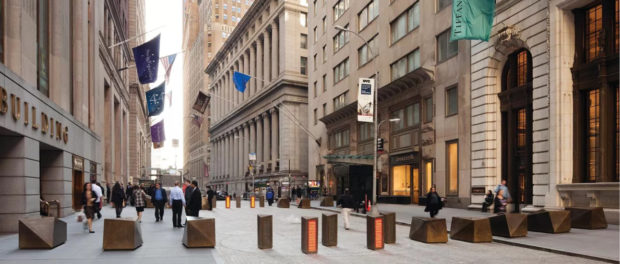The secret of anti-terror architecture: Your city is safer than you realise

No one wants to live behind barricades and barbed wire, but everyone wants to feel safe, particularly in the wake of horrifying, unforeseeable massacres such as the recent terror attack in Barcelona’s Las Ramblas. The problem is that erecting fortress-like protections is, in a way, giving into terror—it allows fear to dictate how we live.
But what if cities could be secured against terror, without looking like war zones? Yours might be, already.
“There are really effective methods to stop lorry attacks and to protect public spaces,” wrote Dominic Casciani for the BBC following the July 14th truck attack in Nice, France. “The US, Israel and the UK are among the nations that have led the thinking on protecting public spaces with the development of measures ranging from in-your-face massive barriers to incredibly subtle changes in the street scene that you and I would barely notice.”

Wall Street Security Project by ROGERS PARTNERS Architects+Urban Designers(ROGERS PARTNERS Architects+Urban Designers)
Since the 2001 terror attacks of September 11, urban planners and architects have learned to negotiate between aesthetics and public safety, creating double-duty structures that secure a city without changing its character. One such ingenious protective detail is the humble bollard.
“When I heard about the Nice attacks, I thought to myself, where were the bollards?,” says California-based photographer Andrew Choate. Choate has compiled a diverse collection of bollards that he’s published on Instagram.
A bollard is typically a short metal post used to direct traffic or secure certain areas on the street. Originally found in shipyards and docks for securing mooring boats in the 18th century, the most common shape of modern bollards came from their maritime history—the ubiquitous domed top references old-fashioned canon balls.
“Crash- and attack-resistant bollards” are required for all US military and governmental buildings, and can be seen in this outline by the US National Institute of Building Sciences. The US Department of State’s “anti-ram vehicle list” (PDF) also lists several types of bollards to protect the perimeter of its embassies abroad. Some bollards are capable of stopping vehicles travelling up to 50mph (80 Km/h).
As Choate shows with the hundreds of examples he’s photographed, bollards today can also take all kinds of shapes, and they’re everywhere—streets, airports, government buildings, highways and side streets. Part of the US visual landscape for decades, most of us don’t even realise they’re there for our safety.
When New York City planners were looking to improve security around New York’s Financial District, they turned to the firm Rogers Partners Architects+Urban Designers, who replaced the “menacing metal barriers” with custom-designed faceted bronze bollards called “No Go.” Described by the Chicago Tribune as “a sparkling example of humanistic, multidimensional security planning,” the large sculptural objects became a friendly place for Manhattan co-workers to gather outdoors.

Hanging out on bollards. (ROGERS PARTNERS Architects+Urban Designers)
Off-the-shelf security bollards frequently take the form of flower planters that add greenery to a building’s perimeter. As the US Federal Emergency Management Agency suggests (pdf, p. 4-1), these types of barriers work as “streetscape enhancement and public realm beautification, rather than as a separate or redundant system of components whose only purpose is security.”

Bollards in Toronto. (Flickr/Payton Chung)
These days there are all too many questionable architecture projects where pure aesthetics drive decisions-making. But perhaps in no other urban planning project does designing for beauty become more essential at a time when we’re besieged with the ugliness of terrorism, with troubling regularity.
As Ruth Reed, president of the Royal Institute of British Architects wrote to introduce to the organization’s 2010 counter-terrorism design guidelines: “It is important that our built environment continues to reflect that we are an open and inclusive society, and that in interpreting these new requirements our buildings do not convey that we are driven by security measures.”
As Ruth Reed, president of the Royal Institute of British Architects wrote to introduce to the organization’s 2010 counter-terrorism design guidelines: “It is important that our built environment continues to reflect that we are an open and inclusive society, and that in interpreting these new requirements our buildings do not convey that we are driven by security measures.”
